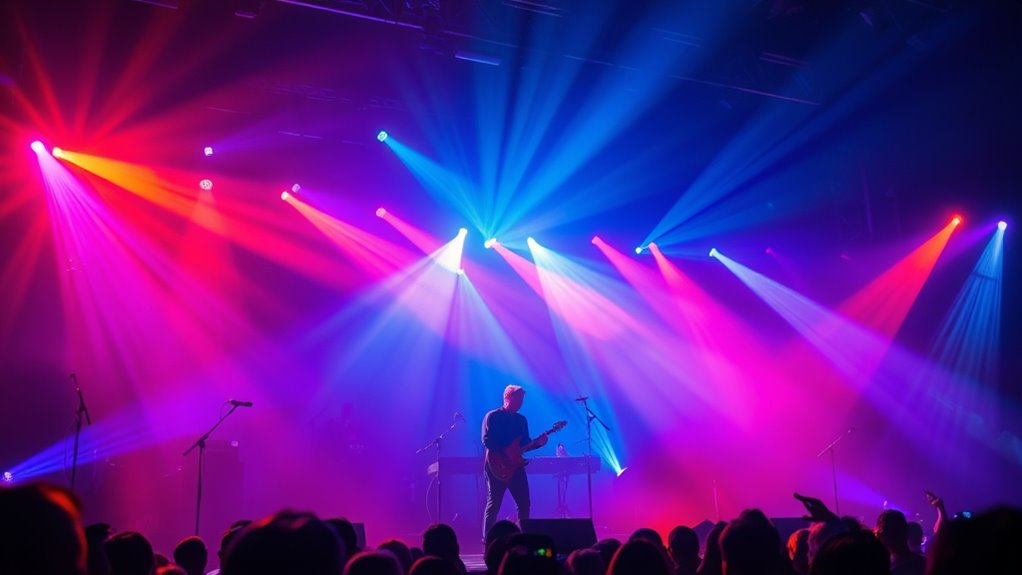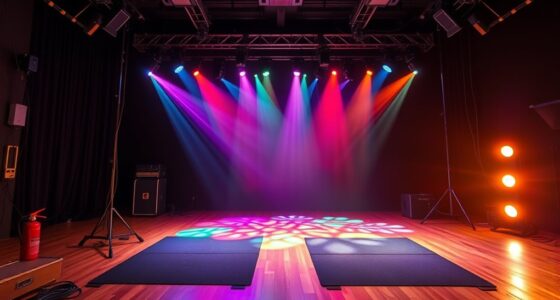Matching music and lighting helps set the perfect mood for any space or event. Use warm, soft lights with relaxing tunes for calm, intimate atmospheres. For lively parties, opt for bright, colorful lighting combined with energetic music to get people dancing. Syncing the lights with the beat enhances excitement, while adjusting brightness creates cozy or energizing feelings. Keep experimenting with colors and effects to discover what best evokes the emotions you want to share. If you keep exploring, you’ll master how to create the ideal ambiance.
Key Takeaways
- Matching music and lighting creates a mood, with bright lights energizing and dim lights calming the atmosphere.
- Color choices like warm reds evoke excitement, while cool blues promote relaxation.
- Adjusting brightness and contrast enhances emotional impact and visual drama.
- Syncing lighting effects to music beats makes events more engaging and lively.
- Proper sound quality and lighting balance are key to creating immersive, memorable spaces.
Why Matching Music and Lighting Matters
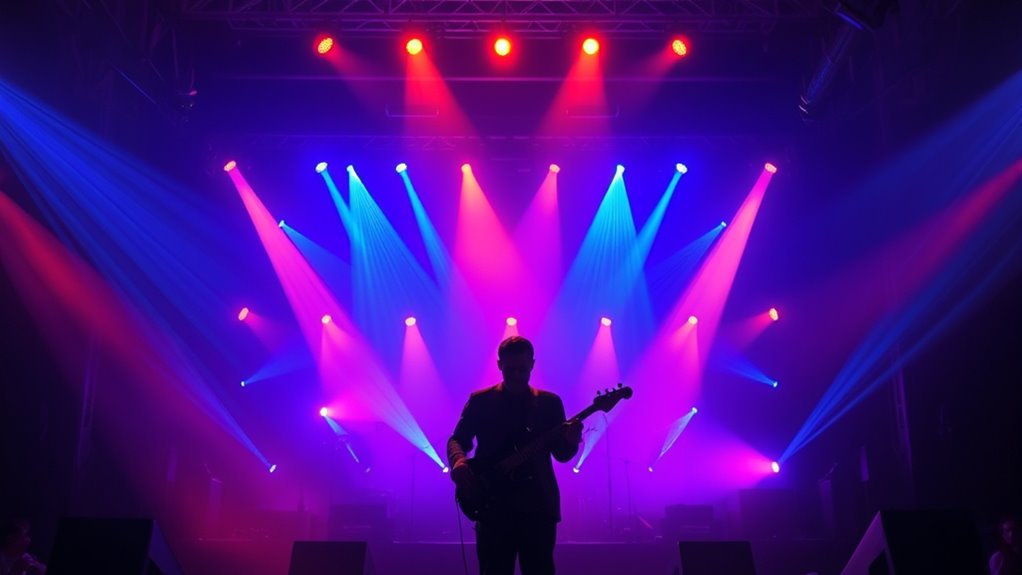
Matching music and lighting is essential because it shapes the overall mood and atmosphere of any event or space. When your sound quality is high and your equipment setup is well-planned, the music becomes more immersive, enhancing the lighting effects. Properly synchronized lighting highlights key moments in the music and creates visual harmony, making the experience more memorable. If the sound setup isn’t clear or equipment isn’t properly adjusted, even the best lighting can fall flat. Conversely, great sound alone won’t set the right tone without complementary lighting. By matching music and lighting thoughtfully, you ensure that both elements work together seamlessly, amplifying the emotional impact and making your event feel polished and engaging. Additionally, understanding sound and lighting synchronization helps in creating more dynamic and engaging environments that captivate your audience.
Choosing the Right Music for Different Moods
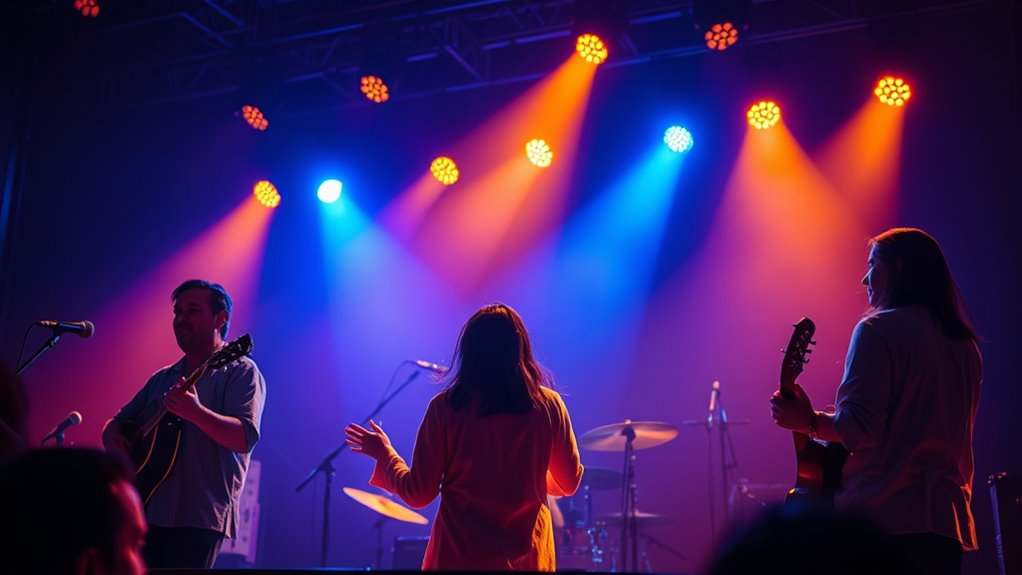
Selecting the right music for different moods is key to setting the tone and engaging your audience effectively. Your choice of musical genres can evoke specific feelings—calm and relaxing with soft jazz or acoustic tunes, energetic and lively with pop or dance beats, and intimate with slow ballads. Matching these genres with appropriate lighting fixtures enhances the atmosphere, making the experience more immersive. For a relaxed vibe, opt for warm, dim lighting paired with mellow music. For high-energy events, bright, dynamic lighting with upbeat tracks works best. Consider how the music’s tempo and genre influence your lighting choices and overall mood. When you align these elements thoughtfully, you create a cohesive environment that resonates emotionally with your audience. Additionally, understanding merchant services and their associated risks can help ensure smooth event transactions and secure payment processing.
Picking Lighting Colors to Complement Your Music
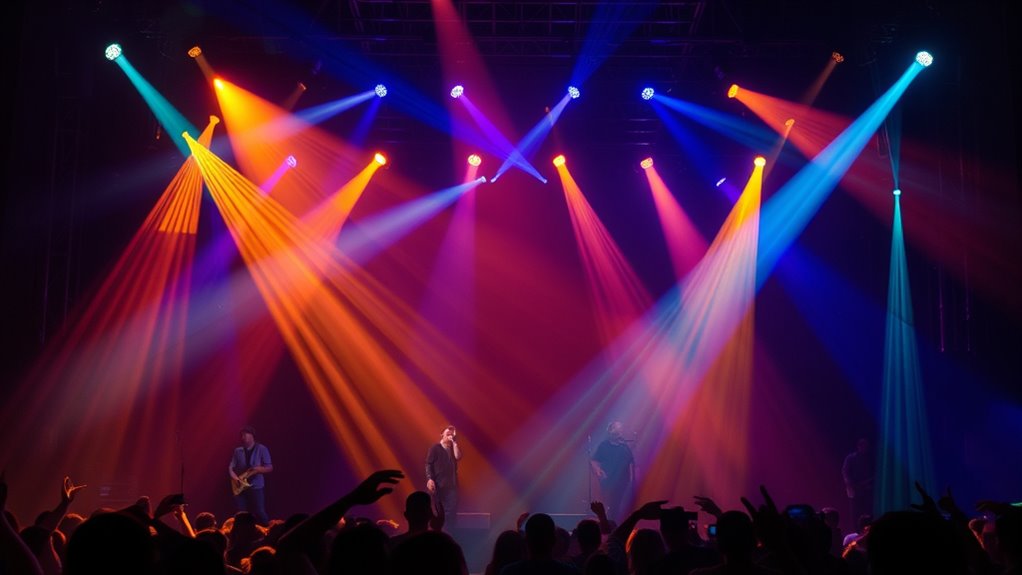
Choosing the right lighting colors can enhance your music’s mood and energy. You should consider color psychology effects and match your lights to the tone you’re aiming for. Balancing brightness and color intensity helps create an immersive experience that complements your sound perfectly. Additionally, understanding zodiac sign compatibility can inspire color choices that resonate with the emotional themes of your music.
Color Psychology Effects
When you pick lighting colors that align with the mood of your music, you can enhance the emotional impact of your performance or event. Color symbolism plays a key role here, as different hues trigger specific emotional responses. For example, warm colors like red and orange often evoke excitement, passion, or energy, while cool colors like blue and green promote calmness and relaxation. Understanding these associations helps you choose the right colors to match the atmosphere you want to create. By intentionally selecting lighting that reflects the emotional tone of your music, you strengthen the connection with your audience. Additionally, incorporating electric bikes into your setup can provide a sustainable and innovative way to power your lighting and sound equipment. This strategic use of color psychology transforms a simple visual element into a powerful tool for amplifying the overall mood and experience.
Matching Mood Tones
Matching the mood tones of your lighting to your music creates a cohesive and immersive experience for your audience. The right colors enhance sound quality perception and complement your equipment setup, making the overall atmosphere more engaging. For example, warm amber lights suit relaxed tunes, while cool blues work better with energetic tracks. Use this table to guide your choices:
| Mood Tone | Recommended Colors |
|---|---|
| Calm | Soft blues, greens |
| Exciting | Bright reds, oranges |
| Mysterious | Deep purples, indigos |
Aligning lighting colors with your music’s mood ensures your audience feels connected. Focus on choosing hues that match the emotional tone, and adjust your equipment setup to support seamless color changes, augmenting the overall experience. Additionally, consider how lighting and sound can work together to heighten emotional impact for your listeners.
Brightness Balance Tips
Balancing brightness levels in your lighting is essential to guarantee your music’s mood remains clear and engaging. Different music genres call for specific lighting fixtures and brightness adjustments to enhance the experience. For energetic genres like pop or rock, use brighter, more vibrant lights to match the excitement. Softer genres, such as jazz or ambient, benefit from dimmer, warmer lighting to create intimacy. When choosing lighting colors, consider complementing your music’s tone—cooler hues work well with calm music, while warmer tones boost lively beats. Adjust brightness gradually to avoid overwhelming your audience or diluting the mood. Experiment with different fixtures and brightness levels to find what best amplifies your music’s emotional impact. Proper balance keeps your lighting engaging without distracting from the music. Understanding lighting techniques can help you tailor your setup for optimal mood enhancement.
Understanding Brightness and Its Effect on Atmosphere
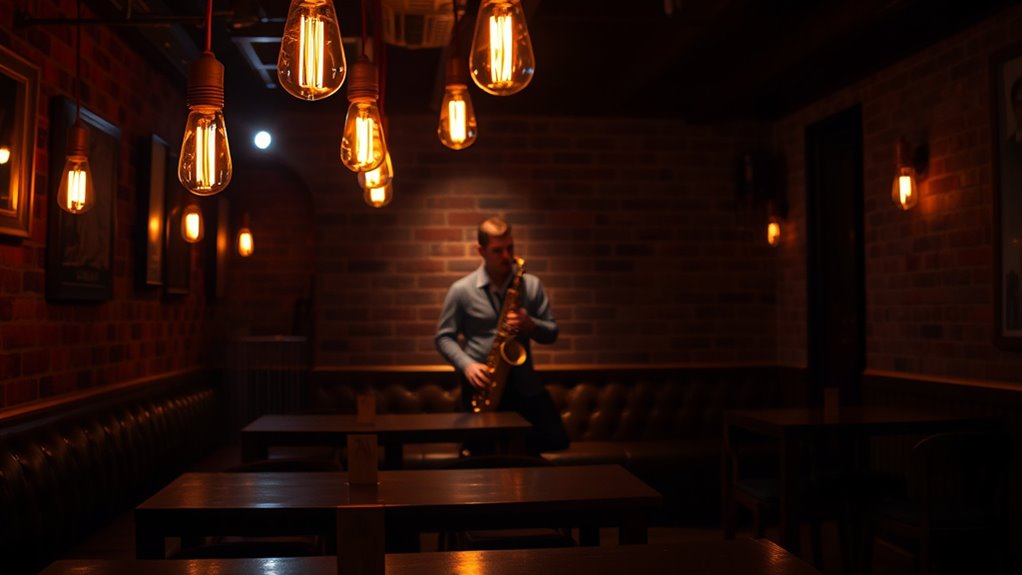
Brightness plays an essential role in shaping the mood and atmosphere of any space. When you adjust dimness levels, you influence how warm or inviting a room feels. Lower brightness creates a cozy, intimate vibe, while brighter settings energize the environment. Contrast ratios also matter—high contrast emphasizes certain areas or objects, drawing attention and adding drama. Conversely, low contrast results in a softer, more uniform look, promoting calmness. Understanding how brightness affects perception helps you set the right tone, whether for lively gatherings or relaxed evenings. Additionally, cookie consent preferences can impact how you customize lighting controls and automation settings in smart home environments. By controlling dimness levels and contrast ratios carefully, you can craft an atmosphere that complements your music and enhances the overall experience.
Creating a Relaxing Environment With Soft Lighting and Calm Tunes
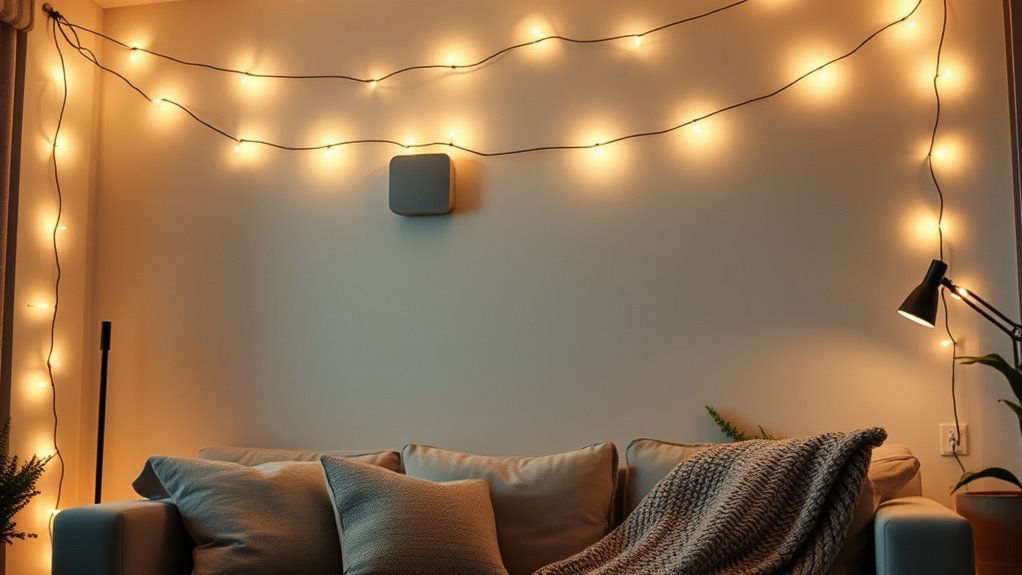
To create a calming atmosphere, opt for gentle lighting like warm lamps or dimmable fixtures that soften the space. Pair this with soothing music that features calm melodies and slow tempos to enhance relaxation. Together, these choices help you craft a peaceful environment where you can unwind and feel at ease. Incorporating visualization techniques can further align your environment with your relaxation goals, reinforcing a sense of calm and focus.
Gentle Light Choices
Creating a calming atmosphere starts with choosing gentle lighting that soothes your senses and sets the mood. Soft, ambient textures like dimmed lamps, fairy lights, or candles create a warm glow, eliminating harsh shadows and promoting relaxation. These gentle lights complement various musical genres, especially those with calming melodies and smooth rhythms. Opt for lights with adjustable brightness to tailor the environment to your mood, whether you want a cozy glow or a subtle shimmer. Combining soft lighting with soothing sounds helps your mind unwind and enhances your overall sense of peace. Incorporating self-watering plant pots into your space can also add a touch of nature’s tranquility, fostering a serene environment. Remember, the goal is to craft a serene space where ambient textures and gentle illumination work in harmony to promote calmness and comfort.
Soothing Music Selection
Choosing the right soothing music can considerably enhance the calming effect of gentle lighting. Opt for instrumental melodies that evoke tranquility without distraction. Soft piano tunes, acoustic guitar pieces, or harp music create a peaceful atmosphere. Additionally, ambient soundscapes—like flowing water, gentle rain, or wind—add an immersive layer of relaxation. These sounds help slow your mind and reduce stress, complementing the calming ambiance created by your lighting choices. Keep the volume low and avoid abrupt changes to maintain a smooth, serene environment. Combining soft lighting with calming tunes invites a sense of comfort, making your space perfect for unwinding, meditation, or quiet reflection. Incorporating ambient soundscapes can deepen relaxation and enhance the overall atmosphere. With the right selection, your environment transforms into a peaceful retreat.
Pumping up Energy With Bright Lights and Upbeat Music
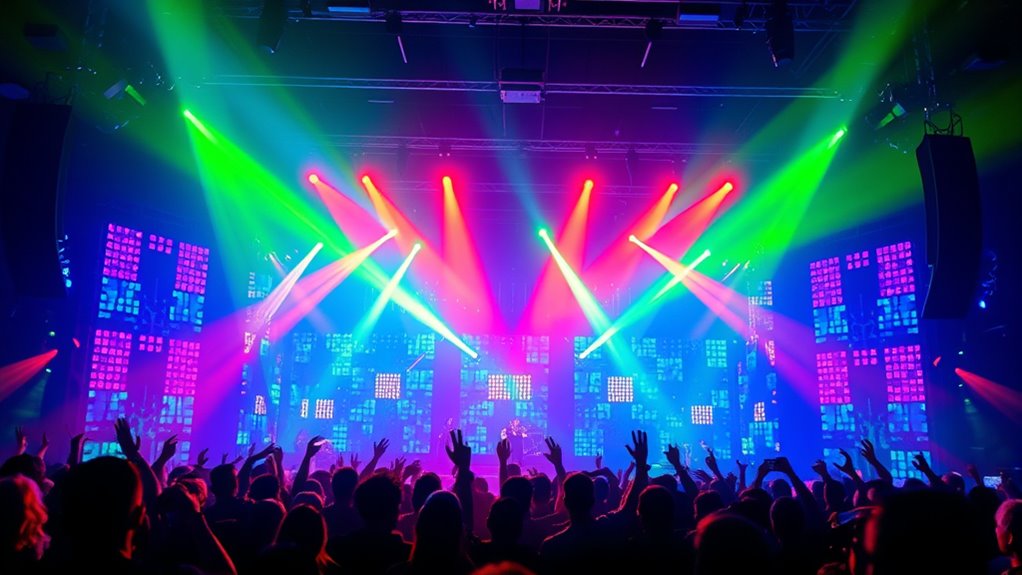
Bright lights and upbeat music are powerful tools for energizing any event or space. When you focus on the dance floor, vibrant lighting can instantly lift the mood and encourage people to move. Bright, dynamic lights that sync with the beat create a lively atmosphere, making the space feel exciting and fun. To maximize this effect, guarantee your sound quality is first-rate—clear, crisp, and well-balanced—so the music hits with impact. Good sound quality keeps the energy high and prevents frustration, allowing everyone to enjoy the rhythm fully. With the right combination of bright lights and upbeat tunes, you’ll transform any area into an energetic hub that invites guests to dance and have a great time.
Setting up for a Romantic Evening With Warm Lights and Gentle Melodies
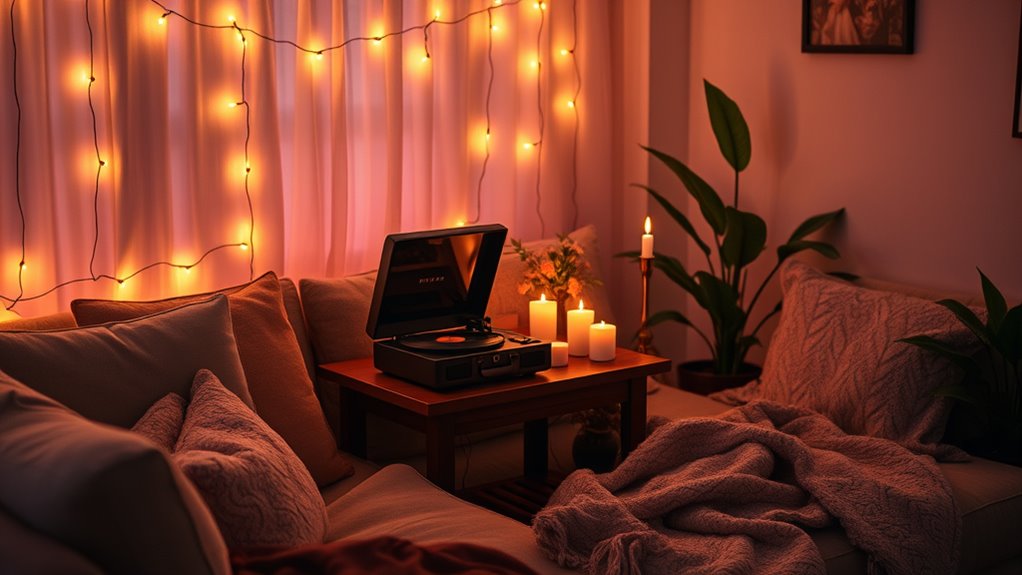
To set the perfect romantic mood, focus on soft, warm lighting that gently illuminates the space. Use dimmed lights or candles around the dance floor to create an intimate atmosphere. Keep the sound system tuned to play gentle melodies or love songs at a comfortable volume, ensuring the music isn’t overpowering. Position the speakers so that sound flows smoothly across the room, allowing you and your partner to enjoy the music without distraction. Keep the lighting low enough to foster closeness but bright enough to see each other clearly. This setup encourages relaxed interactions and meaningful conversations. Remember, the goal is to create an inviting environment where warmth, music, and ambiance blend seamlessly.
Using Lighting to Highlight Key Moments in a Party
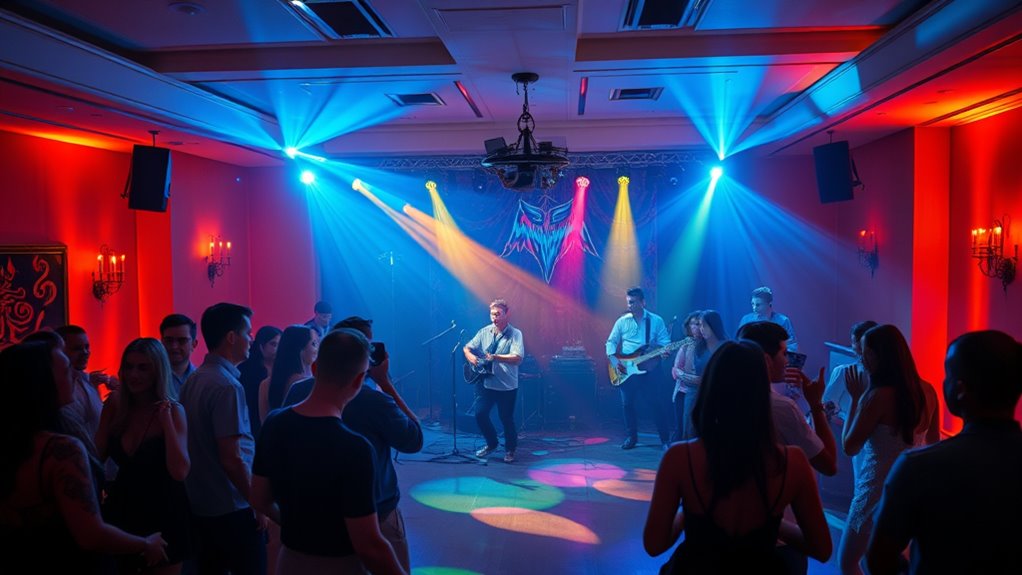
You can make key moments stand out by using spotlights to draw attention to the dance floor or a special performance. Incorporating color changes in your lighting adds drama and emphasizes shifts during the event. These techniques help create memorable highlights that keep your guests engaged and excited.
Spotlights for Focus
Spotlights are an effective way to draw attention to key moments during a party, ensuring your guests focus on the most important events. Using spotlights for focus helps highlight speeches, performances, or special announcements, making these moments stand out. You can position a spotlight to follow the action smoothly, creating a dramatic effect that captures everyone’s attention. Incorporating accent lighting with spotlights adds depth and visual interest, guiding your guests’ eyes exactly where you want them. Keep the spotlight intensity adjustable so it doesn’t overpower the scene but still remains eye-catching. Proper placement and timing of these lights make your event feel more professional and engaging, emphasizing the significance of each highlighted moment without overwhelming the overall ambiance.
Color Changes for Drama
Color changes can dramatically elevate key moments during a party by adding visual interest and emphasizing specific events. By using color symbolism, you can evoke particular emotions and set the mood for each moment. For example, fiery reds can create excitement during speeches, while calming blues foster intimacy during heartfelt toasts. Changing colors strategically highlights important *progressions* and highlights, making the experience more memorable. The emotional impact of lighting helps guide your guests’ feelings, whether building anticipation or providing a sense of calm. You can also shift colors gradually to create a seamless flow or use sudden changes for dramatic effect. Thoughtful color choices turn simple lighting into a powerful storytelling tool, ensuring your party’s highlight moments resonate deeply with everyone present.
Simple Tips for Synchronizing Your Music and Lighting

Aligning your music with lighting effects can considerably enhance the atmosphere of any event or setup. To achieve seamless synchronization, focus on key elements like sound frequency and rhythm synchronization. Match lighting changes to beat drops or tempo shifts for maximum impact. Use a simple beat meter or software to visualize rhythm timing. Here’s a quick guide:
| Tip | Explanation |
|---|---|
| Use a metronome or software | Keeps your lighting synced with beat and tempo. |
| Match sound frequency to lights | Adjust light flicker to bass or treble for harmony. |
| Focus on rhythm cues | Sync lighting changes precisely with musical accents. |
| Adjust timing in real-time | Make quick tweaks during setup for perfect sync. |
| Test with different tracks | Ensure your setup works across various music styles. |
These tips help you create a cohesive, lively atmosphere through precise sound and light coordination.
Easy Ways to Experiment and Find Your Perfect Match

Experimenting with different music and lighting combinations is the best way to discover what truly enhances your event’s atmosphere. Start by trying various music genres, from upbeat pop to mellow jazz, and see how each influences the mood. Pair these with different lighting fixtures—such as warm-colored LEDs or dynamic spotlights—and observe how they complement the music. Don’t be afraid to switch things up and take notes on what feels right. Use simple adjustments, like changing the brightness or color of your lights, to see what best matches the rhythm and energy of your chosen music. This hands-on approach helps you identify combinations that create the perfect vibe for your event, making it more memorable and enjoyable for everyone.
Frequently Asked Questions
How Can I Incorporate Music and Lighting Into Small Spaces?
To incorporate music and lighting into small spaces, choose compact, multifunctional fixtures like wall-mounted speakers and adjustable LED lights. Address soundproofing challenges by adding fabric-covered decorative accessories, such as cushions or rugs, which absorb sound. Use dimmable lights to create ambiance and highlight key areas. Keep the setup simple and clutter-free, ensuring your music and lighting enhance the space without overwhelming it.
What Budget-Friendly Options Are Available for Matching Music and Lighting?
Think of your space as a stage where you’re the director. For budget-friendly options, try DIY projects like repurposing string lights or using affordable Bluetooth speakers. Budget tips include shopping sales, choosing multi-functional lighting, and creating playlists that match your vibe. You don’t need to spend a fortune—simple swaps and creative DIY touches can turn your small space into a cozy, stylish scene without breaking the bank.
How Do I Troubleshoot Synchronization Issues Between Music and Lighting?
To troubleshoot synchronization issues between music and lighting, start by checking for audio delay—adjust the latency settings if available. Make certain all devices are connected properly and update firmware if needed. Also, verify there are no connectivity issues, such as weak Wi-Fi signals or loose cables, which can cause delays. Restart your equipment to reset any glitches, and test again to see if the synchronization improves.
Can Smart Home Devices Help Automate Music and Lighting Coordination?
Yes, smart home devices can automate your music and lighting coordination, transforming your space into a seamless experience. Imagine effortlessly controlling everything with voice commands, setting the perfect scene in seconds. With scene customization options, you can tailor lighting and music to match your mood or activity. This integration creates an immersive environment, making your home both smarter and more responsive—bringing every moment to life with just a simple command.
How Do Weather Conditions Affect Outdoor Music and Lighting Setups?
Weather conditions substantially impact your outdoor music and lighting setups. Weather hazards like rain, snow, or high winds can damage equipment and cause safety issues. Humidity and moisture affect lighting impact, making lights flicker or short-circuit. To prevent problems, use weatherproof devices, set up covers, and monitor forecasts. Adjust your plans accordingly, ensuring your outdoor ambiance remains safe and effective regardless of changing weather conditions.
Conclusion
Now that you know the basics, imagine the magic you can create when you perfectly sync your music and lighting. The right combination can transform any space into an unforgettable experience—whether it’s calming, romantic, or energetic. But here’s the secret: the best moments come from your own experimentation. So, are you ready to discover your perfect match and surprise everyone with an atmosphere they’ll never forget? The possibilities are waiting—you just have to take the first step.
